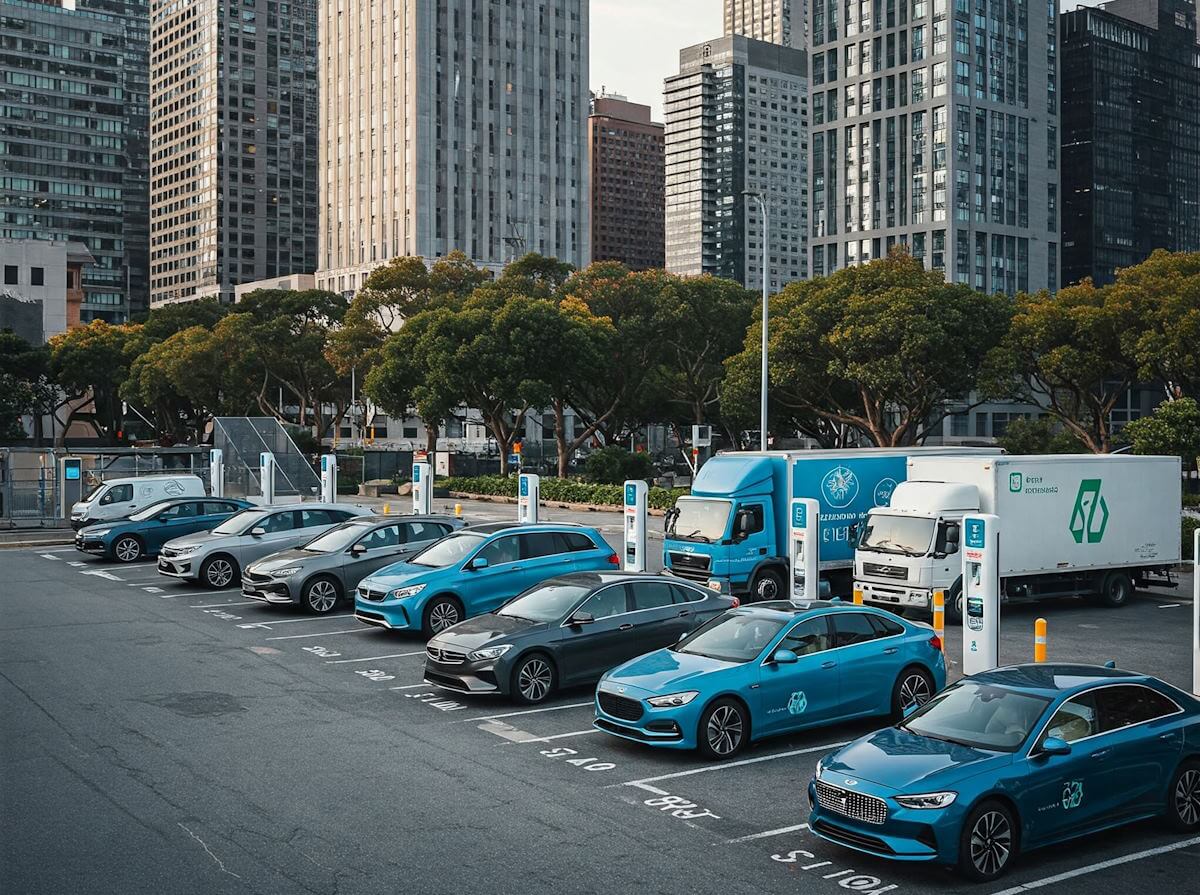Electric vehicle (EV) fleets represent a transformative shift in the way businesses approach transportation and logistics. As companies increasingly seek sustainable solutions, the integration of EVs into their operations has become a strategic focus. An EV fleet consists of multiple electric vehicles used for various purposes, including delivery, transportation, and service operations. These vehicles utilize electric power, often sourced from rechargeable batteries, which can significantly reduce greenhouse gas emissions compared to traditional internal combustion engines.
The adoption of electric vehicles in commercial fleets has been accelerating in recent years. According to recent statistics, the number of electric vehicles on the road is projected to surpass 300 million globally by 2040, with a significant portion of this growth attributed to commercial use. Moreover, many businesses are acknowledging the financial benefits of transitioning to EVs, including savings on fuel costs and maintenance. For instance, the annual operating costs of EVs can be up to 40% lower than those of their gasoline counterparts, making them an attractive option for businesses seeking to improve their bottom line.
Motivated by sustainability goals and regulatory pressures, organizations across various industries are increasingly adopting electric fleets. Governments worldwide are introducing incentives and regulations aimed at reducing carbon footprints, further encouraging the shift toward electric mobility. The business rationale extends beyond compliance; companies are also recognizing that consumer preference is shifting toward environmentally friendly practices. By deploying EV fleets, businesses can enhance their brand image and appeal to a growing customer base that prioritizes sustainability.
In this context, understanding the essentials of electric vehicle fleets is crucial for businesses aiming to stay competitive and environmentally responsible in today’s economy. The evolution toward cleaner and more efficient transportation solutions is a pivotal step in addressing global challenges related to climate change and resource depletion.
The Financial Impact of Transitioning to EV Fleets
Transitioning to electric vehicle (EV) fleets presents a significant financial opportunity for businesses. While initial investments may seem daunting, the long-term savings often outweigh these upfront costs. One of the most compelling advantages of EV fleets is the potential for lower fuel costs. As electric vehicles consume electricity rather than traditional fuel, businesses can experience substantial reductions in their operational costs. According to various studies, the cost of electricity for charging EVs is often significantly less than spending on gasoline or diesel, leading to a favorable cost-to-mile ratio.
Another critical aspect to consider is the reduced maintenance associated with EV fleets. Electric vehicles typically have fewer moving parts compared to conventional vehicles, which translates to lower maintenance expenses. For instance, EVs do not require oil changes, and brake wear is minimized due to regenerative braking systems. Consequently, businesses can significantly cut down on routine maintenance costs, improving their overall profit margins over time.
Moreover, there are various tax incentives and rebates available for businesses transitioning to electric fleets. Government programs often provide financial credits for purchasing EVs, further decreasing the overall expenditure associated with fleet electrification. These incentives can greatly reduce the payback period for the initial investment, making the transition more enticing for business owners. Furthermore, as societal support for sustainable practices continues to grow, expenses related to carbon emissions and compliance with environmental regulations may also decrease, creating a healthier financial environment for businesses embracing electric fleets.
In summary, while the initial costs of switching to EV fleets may require careful consideration, the long-term financial advantages—including lower fuel and maintenance costs and potentially lucrative tax benefits—provide a clear incentive for businesses looking to enhance their costs’ efficiency and sustainability.
Environmental Benefits of EV Fleets
As the world increasingly prioritizes sustainability, businesses are finding electric vehicle (EV) fleets to be an effective means to contribute to environmental conservation. The adoption of EV fleets offers significant reductions in greenhouse gas emissions compared to traditional combustion engine vehicles. By utilizing electric vehicles, companies can markedly decrease their carbon footprint, as EVs emit no tailpipe emissions. This shift not only aligns with global efforts to mitigate climate change but also positions businesses as leaders in sustainability.
Furthermore, EV fleets contribute to lower levels of air pollution, which presents a myriad of health benefits for communities. With diminished emissions of harmful pollutants such as nitrogen oxides and particulate matter, the transportation sector’s shift toward electric vehicles aids in creating cleaner air. This directly supports public health initiatives and community well-being, reinforcing a company’s role as a responsible corporate citizen. Businesses adopting EV technology can thereby enhance local living conditions, demonstrating their commitment to environmental stewardship.
Moreover, the integration of EV fleets aligns seamlessly with corporate sustainability initiatives. Many organizations are increasingly expected to adopt practices that not only promote profit but also emphasize social responsibility. By implementing electric vehicles in their operations, companies fulfill their corporate social responsibility (CSR) goals, showcasing their dedication to reducing environmental impact. This commitment to sustainable practices can enhance a company’s image, appealing to eco-conscious consumers and investors alike. Ultimately, embracing EV fleets represents a proactive approach to sustainability, helping businesses achieve their environmental objectives while simultaneously strengthening their market position.
Operational Efficiency through Electric Vehicle Fleets
The integration of electric vehicle (EV) fleets into business operations presents significant opportunities for enhanced operational efficiency. One of the primary advantages of adopting EV fleets is the ability to improve routing capabilities. EVs are equipped with advanced navigation systems that analyze traffic conditions and optimize routes in real-time. This capability ensures that vehicles reach their destinations more quickly, reducing fuel consumption and overall travel time. Improved routing not only saves costs but also enhances customer satisfaction through timely deliveries.
Another important aspect of operational efficiency is enhanced tracking. Modern EV fleets often incorporate GPS tracking systems that provide real-time data on vehicle location, speed, and performance metrics. Fleet managers can monitor these parameters to make informed decisions, such as reallocating resources or adjusting schedules based on current demands. This real-time visibility allows for proactive management of fleet operations, minimizing the risk of vehicle downtime and optimizing vehicle use throughout the day.
Moreover, the utilization of advanced fleet management software plays a critical role in the operational efficiency of EV fleets. These software solutions provide comprehensive insights into vehicle performance, maintenance requirements, and driver behavior. By analyzing this data, businesses can identify areas for improvement, enhance driver training, and schedule preventative maintenance effectively. Consequently, fleet managers can ensure that each vehicle operates at its peak performance, further contributing to productivity and reducing unplanned maintenance costs.
The transition to electric vehicle fleets not only supports environmental goals but also drives operational improvements across numerous sectors. By leveraging technology for enhanced routing and tracking, as well as adopting sophisticated fleet management solutions, businesses can achieve significant cost savings and bolster their overall operational efficiency.
Overcoming Challenges in Adopting EV Fleets
The transition to electric vehicle (EV) fleets presents several challenges for businesses that must be carefully navigated to achieve successful deployment. One of the most prevalent obstacles is range anxiety. Businesses often worry about the distance their electric vehicles can cover on a single charge, especially for operations that require long trips or irregular routes. To mitigate this concern, companies can conduct thorough assessments of their operational needs, determining the average distance traveled and identifying routes that can accommodate electric vehicles. By ensuring that vehicle models selected have an adequate range and incorporating a fleet management system that optimizes routing, businesses can effectively alleviate range anxiety among drivers.
Another significant hurdle in adopting EV fleets is the need for robust charging infrastructure. Many companies fear the implications of limited charging facilities, which could lead to operational downtimes. To address this, businesses should assess the availability of public charging options and consider investing in on-site charging stations at their facilities. Collaborating with local utility providers can also facilitate access to incentives for installing charging infrastructure, ensuring that employees have easy access to charging and reducing fears related to charging availability.
Additionally, vehicle availability can pose a challenge, as some businesses may struggle to find appropriate EV models that meet their needs. It is crucial for organizations to research the current market thoroughly, considering both established and emerging electric vehicle manufacturers. Leveraging partnerships with automotive dealers can also provide insights into trends and vehicle options suited to specific operational requirements. By implementing these strategies, businesses can successfully overcome the barriers to adopting electric vehicle fleets, ultimately unlocking significant cost savings and sustainability benefits.
Case Studies: Successful EV Fleets in Business
The adoption of electric vehicle (EV) fleets by businesses has been gaining momentum across various industries, showcasing not only the environmental benefits but also significant economic advantages. This section will highlight several exemplary case studies that demonstrate how organizations have effectively implemented EV fleets and the results they have achieved.
One notable example is a large logistics company that integrated an all-electric fleet, consisting of over 500 delivery vans. The organization faced initial challenges, including range anxiety and the need for charging infrastructure. To overcome these obstacles, they invested in a network of charging stations within their distribution centers and strategically located routes. After a year of implementation, the company reported a reduction in fuel costs by 40%, translating to substantial savings that contributed to their overall profitability. Moreover, the switch to electric vehicles significantly lowered greenhouse gas emissions, aligning with their sustainability goals.
Another case study involves a national ride-sharing company that transitioned a portion of its fleet to electric vehicles. By collaborating with local governments and establishing partnerships with EV manufacturers, the company effectively addressed the challenges of vehicle availability and charging accessibility. The resulting fleet not only enhanced the company’s green image but also attracted eco-conscious riders, leading to an increase in user engagement and client satisfaction. Furthermore, the operational costs decreased by 30% due to lower maintenance and fuel expenses associated with EVs.
Lastly, a regional public transportation authority successfully launched an electric bus fleet within urban areas. The project was initially met with skepticism regarding range and charging times. However, through careful planning and pilot programs, they demonstrated the feasibility and benefits of electric buses. Within two years, the agency reported a 25% decrease in overall operational costs and a significant improvement in air quality in the areas served. These case studies encapsulate the evolution of businesses toward adopting EV fleets and illustrate the potential for cost savings and environmental stewardship.
Future Trends in EV Technology and Fleet Management
The electric vehicle (EV) market continues to evolve at a rapid pace, with promising advancements in technology and fleet management practices on the horizon. One of the most impactful areas of development is in battery technology. Innovations such as solid-state batteries are predicted to enhance energy density, thereby increasing the range of electric vehicles significantly. This improvement not only addresses one of the main concerns for businesses operating fleets but also allows for longer operational hours without the need for frequent recharging. Furthermore, these advancements are anticipated to decrease charging times, making EVs more accessible for daily business use.
Autonomous driving capabilities represent another exciting trend in the EV sector. The integration of sophisticated sensors, machine learning algorithms, and advanced navigation systems is paving the way for vehicles that can operate with minimal human intervention. For fleet managers, this could translate into increased efficiency and reduced labor costs, as autonomous vehicles can optimize routes and minimize downtime. Companies can leverage this technology to streamline operations, reduce accidents, and provide enhanced services to customers.
Software integrations are also becoming increasingly crucial in fleet management. Innovations in fleet management software can enable real-time tracking of vehicle performance, maintenance needs, and energy consumption. This data-driven approach aids businesses in making informed decisions regarding their fleets, allowing for predictive maintenance and significant cost savings over time. Additionally, the rise of software platforms that facilitate energy management will help businesses optimize charging times and costs, taking advantage of off-peak rates and renewable energy sources.
Overall, as electric vehicle technology continues to mature, the combination of improved battery efficiency, autonomous features, and integrated software systems will undeniably enhance the viability of EV fleets for businesses. Embracing these innovations not only contributes to cost savings but also positions companies as leaders in sustainable practices in their industries.
Government Incentives and Support for EV Adoption
The transition to electric vehicle (EV) fleets for businesses is significantly influenced by government initiatives aimed at enhancing EV adoption. Both federal and state governments offer a variety of incentives and support programs to mitigate the costs associated with this transition, thereby encouraging businesses to make the switch to electric transportation.
At the federal level, one of the most notable incentives is the federal tax credit for electric vehicles, which can provide a substantial reduction in the purchase price of eligible EVs. This credit varies based on the capacity of the battery in the vehicle, with a maximum potential credit of up to $7,500. Furthermore, businesses may also benefit from various grants and funding opportunities aimed primarily at developing and expanding electric vehicle infrastructure, such as charging stations. These financial incentives can significantly reduce the initial investment required when transitioning to an electric fleet.
In addition to federal incentives, many states have enacted programs tailored to support EV adoption among businesses. These programs often include state tax credits, rebates on the purchase of electric vehicles, and additional grants for infrastructure development. Some states also offer low-interest loans specifically for businesses looking to finance their transition to electric fleets. Furthermore, many local governments have implemented policies that promote EV use, such as reduced registration fees for electric vehicles or exemptions from certain tolls.
Beyond financial incentives, government support for EV adoption can also take the form of educational resources and technical assistance. These programs help businesses navigate the complexities of integrating electric vehicles into their operations, ensuring that they maximize the potential benefits of adopting an EV fleet. As the demand for sustainable transportation solutions grows, the importance of these government initiatives will become increasingly critical in facilitating a smoother transition to electric vehicles.
Conclusion: Embracing Electric Fleets for a Sustainable Future
Transitioning to electric vehicle (EV) fleets offers businesses a multitude of benefits that extend beyond mere cost savings. As organizations grapple with the increasing costs of fuel and maintenance associated with traditional internal combustion engine vehicles, EVs present a more economical alternative in the long run. The reduction in fuel expenses, combined with lower maintenance requirements, leads to significant financial savings. Businesses can leverage these advantages to improve their operational efficiency and redirect resources towards growth and innovation.
Moreover, the environmental benefits of adopting electric fleets cannot be overstated. By moving towards EVs, companies actively contribute to reducing greenhouse gas emissions and enhancing air quality. This commitment to sustainability not only aligns with corporate social responsibility efforts but also resonates with consumers who are becoming increasingly environmentally conscious. As such, businesses adopting electric vehicles can improve their brand image while appealing to a growing market segment that prioritizes sustainability.
It is essential for businesses to view the transition to electric fleets not merely as a financial decision but as an integral part of a sustainable operational strategy. By embracing EVs, companies not only position themselves as leaders in sustainability but also harness the opportunity to innovate and adapt to changing market conditions. The shift towards electric vehicles opens up numerous possibilities for collaborations, government incentives, and advancements in technology that further enhance operational efficiency.
In summary, embracing EV fleets can lead to substantial cost reductions, improved brand reputation, and a commitment to sustainability. The time is ripe for businesses to evaluate the potential benefits of electric vehicle integration and to take proactive steps toward a more sustainable future. Exploring the landscape of electric vehicles presents a pathway not only to greater economic viability but also to a more sustainable business model.




